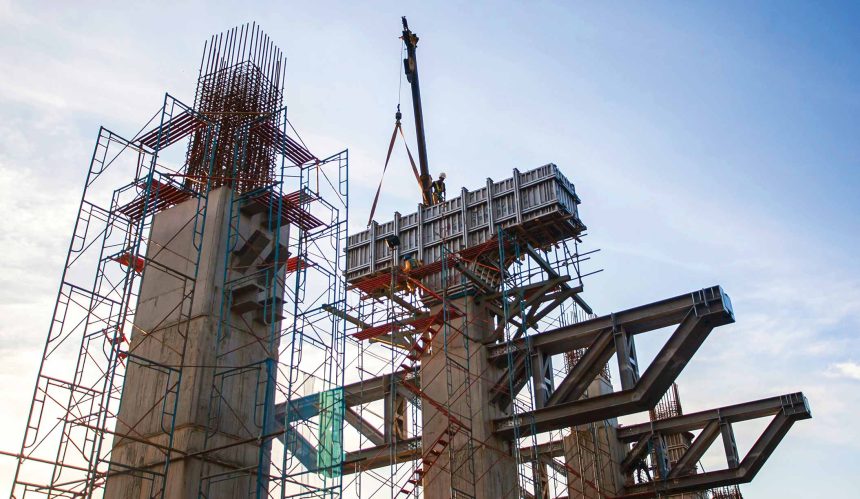Liga Asuransi – Owners, contractors and project consultants, how are you? May you, your family and your business always be in the best condition. In this blog, we focus on discussing risk management and insurance, this time specifically discussing how to handle construction insurance claims so that the process is easier, faster and not rejected. Many contractors face obstacles in submitting claims due to a lack of understanding of the procedures and documents required. Don’t let your project suffer losses due to rejected claims! If you find this article useful, share it with your colleagues and find hundreds of other interesting articles on this blog!
Construction projects are a sector full of risks, ranging from work accidents, natural disasters, theft of materials, to project delays which can have a major impact on costs and work schedules. To anticipate this, construction insurance exists as financial protection for contractors and project owners. By having the right insurance policy, the risks that occur can be covered by the insurance company, so that the project continues as planned.
However, in practice, submitting a construction insurance claim is not a simple process. Many contractors and project owners face challenges such as lengthy claims procedures, incomplete documents, or even claim rejections due to administrative errors. Small errors in reporting or lack of documentation can result in claims not being paid, ultimately impacting project viability.
This article will provide complete guidance on how to file a construction insurance claim quickly and efficiently. You will learn the claim steps, required documents, and how to avoid mistakes that can lead to claim rejection. With good understanding, contractors and project owners can ensure that their claims are processed smoothly and receive appropriate payments. 🚀
Steps to Submit a Project Insurance Claim
Filing a construction project insurance claim is not something that can be done carelessly. Each stage must be carried out correctly so that claims can be processed quickly and are not rejected by the insurance company. The following are the steps that must be followed by contractors or project owners when submitting a construction insurance claim.
- Reporting Incidents as Quickly as Possible
The first step in the claims process is to report the incident to the insurance company as soon as possible. Insurance policies usually set a reporting deadline, and if this deadline is exceeded, the claim may be rejected. Therefore, the contractor or project owner should contact the insurance company or insurance broker immediately after an incident occurs.
How to Make a Clear Incident Report that Complies with Insurance Standards:
- Use a formal report format that includes the following information:
- Date and time of incident.
- Project location.
- Brief description of the incident.
- Losses occur, both in physical and financial form.
- Actions taken after an incident occurs.
- Include witness reports if possible to support claims.
- Immediately send the report to the insurance company or broker so that the claims process can begin.
- Gather Evidence of Loss and Supporting Documentation
To strengthen claims, complete and valid evidence is needed. Without sufficient documentation, the insurance company may deny or only pay part of the claim.
Documents to be Collected:
- Photos and Videos
- Take photos from various angles that show the damage or accident that occurred.
- If possible, record video to provide a clearer picture of conditions at the project site.
- Chronology of Events Report
- Create a report that explains in detail how the incident occurred and its impact on the project.
- Eyewitness Reports
- If there are employees or other parties who witnessed the incident, ask for their statements as additional evidence.
- Documents from Authorities
For incidents such as fires, explosions, or serious work accidents, reports from the police, fire department, or project inspection team are essential to support claims.
- Fill out the Claim Form Correctly
After all the evidence is collected, the next step is to fill out the construction insurance claim form.
Steps in Filling in the Claim Form:
- Ensure all information matches the prepared incident report.
- Fill in all columns completely and clearly to avoid processing delays.
- Include estimated loss values based on reports from technicians or the project team.
- Add all supporting documents requested by the insurance company.
- Mistakes to Avoid:
- Filling in data that is inaccurate or does not match the incident report.
- Lack of supporting documents, which may cause the claim to be delayed or rejected.
- Submitting a claim beyond the time limit specified in the policy.
- Inspection by Insurance Company and Adjuster
After the claim form is submitted, the insurance company will conduct an inspection and investigation to assess whether the claim is valid.
Processes Carried Out by Insurance Companies:
Appointment of Loss Adjuster
- A loss adjuster is an independent party appointed by an insurance company to evaluate losses that occur.
- They will conduct a visit to the project site to verify the damage, cause of the incident, and validity of the claim.
- Document and Evidence Analysis
- The insurance company will check whether the evidence and documents provided match the reported incident.
- If there are deficiencies, they can request additional documents or information before making a decision.
- Determining the Amount of Losses to Be Covered
- The loss adjuster will calculate how much costs can be claimed based on the policy coverage.
- If a discrepancy is found with the policy provisions, the claim amount can be reduced or rejected completely.
- Claim Decision and Payment Process
Once the investigation is complete, the insurance company will determine whether the claim was approved, denied, or only partially paid.
Factors Influencing Claim Decisions:
- Whether the claimed event is covered by the policy.
- Quality of evidence and documentation provided.
- The extent of the loss and its suitability for the coverage in the policy.
- If the claim is approved, the insurance company will issue a payment based on the calculations that have been made.
Estimated Claim Payment Time:
- Simple claims (minor damage) are usually resolved within 30 – 60 days after complete documents are received.
- Complex claims (natural disasters, fires, or project delays) may take longer, depending on the results of the loss adjuster’s investigation.
- If a claim is rejected or paid only in part, the project owner or contractor can submit an appeal with additional evidence or further clarification.
Submitting a construction project insurance claim requires careful preparation, complete documentation, and a good understanding of the claims procedure. The main steps that must be taken include reporting incidents as quickly as possible, collecting strong evidence, filling out the claim form correctly, and understanding the investigation process by the insurance company and loss adjuster.
By following proper procedures, contractors and project owners can ensure that their claims are processed quickly and payments are received according to the coverage amount in the policy.
To make claims easier and faster to approve, use the services of an insurance broker such as L&G Insurance Broker. With experience in managing construction project claims, L&G Insurance Brokers is ready to assist you in every step of your claim to ensure your project remains protected!
Documents Required for Construction Insurance Claims
Filing a construction insurance claim requires the preparation of complete and accurate documents. Many claims are delayed or even rejected because the documents submitted do not meet the insurance company’s standards. Therefore, contractors and project owners must understand what documents are required in the claims process so that the application can run smoothly and claim payments can be received immediately.
The following is a list of documents that must be prepared when submitting a construction project insurance claim.
- Basic Documents that Must Be Prepared
The basic documents serve as administrative proof that the project does have insurance coverage and claims are submitted in accordance with the terms of the policy.
Basic documents that must be prepared:
- Construction Project Insurance Policy
- It is the main document that shows the type of insurance coverage that the project has.
- Make sure the policy submitted is a policy that is still active and covers the risks claimed.
- Official Claim Submission Letter
- A letter submitted by the contractor or project owner to the insurance company.
- Must include information about the incident, such as the date of the incident, project location, type of loss, and number of claims filed.
- Proof of Insurance Premium Payment
The insurance company will not process a claim if the premium has not been paid or there is a delay in payment.
Make sure to attach proof of the last premium payment to prove that the policy was active at the time the incident occurred.
- Documentation of Proof of Loss
Physical evidence is very important in strengthening construction project insurance claims. The more complete the documentation presented, the faster the claim will be processed by the insurance company.
Documentation that must be prepared:
- Complete Incident Report
- Contains a detailed chronology of events, including the causes and impacts of damage.
- If any emergency actions have been taken, such as extinguishing a fire or evacuating workers, they must be included in the report.
- Photos and Videos Before and After the Incident
- Photos and videos are very helpful in proving the scale of the damage that occurred.
- Make sure the documentation covers multiple points of view, both close up and far away.
- Reports from the Police or Relevant Authorities (If Applicable)
For cases such as fire, theft of project materials, or work accidents, reports from the police, fire department, or work safety agency are very necessary.
If the incident occurred due to external factors, such as a natural disaster or traffic accident that impacted the project, a report from the authorities can substantiate the claim.
- Loss Report and Estimated Repair Costs
After an incident occurs, the insurance company needs to know how much loss must be paid. Therefore, a technical report and repair cost estimates must be prepared.
Required documents:
- Report from the Project Engineer or Technician
- This document explains the extent of damage and its impact on project continuity.
- If damage occurs to building structures or heavy equipment, there needs to be a technical analysis regarding the severity and corrective steps required.
- Estimated Repair Costs from Contractors or Vendors
- The insurance company will need a breakdown of costs from the contractor or vendor who will carry out the repairs.
- The estimate should include the cost of materials, labor, and time to complete the job.
- If there are components or equipment that need to be replaced, attach the purchase price or invoice from the supplier.
- Additional Supporting Documents
Sometimes, construction project insurance claims also involve other factors such as lawsuits from third parties or project delays due to incidents that occur. In this situation, additional documents will need to be included to substantiate the claim.
- Additional documents that may be required:
- Legal Documents and Proof of Project Responsibility
- If the claim involves a lawsuit from a third party (for example, property owners around the project who experienced damage due to construction work), it is necessary to include:
- Letter of demand or lawsuit from a third party.
- Evidence that the project has followed applicable safety standards and procedures.
- Report on Causes of Project Delays
- If the claim relates to Delay in Start-Up (DSU) Insurance, a report regarding the cause of the delay must be included.
This report should explain:
- External factors or incidents that cause a project to be delayed.
- Financial impact due to delays (e.g. additional equipment rental costs, labor, or penalties from the client).
- Project Safety Audit and Evaluation Report
- If a workplace accident occurs, the insurance company may request a project safety audit report before the incident occurs.
- This document can prove that the project met safety standards before the accident occurred.
Complete and accurate documents are the main key so that construction project insurance claims can be processed quickly. Each claim must be accompanied by basic documents, proof of loss, technical report, and additional supporting documents if necessary.
To ensure claims are successfully accepted, project owners and contractors must prepare all of these documents from the start and work closely with a professional insurance broker. L&G Insurance Broker is ready to assist you in preparing complete claim documents and ensuring that claims are processed quickly and efficiently! 🚀
Reasons Why Claims Are Rejected and How to Avoid Them
Filing an insurance claim for a construction project requires proper preparation and appropriate procedures. Unfortunately, many claims are denied or only partially paid for various reasons, such as policy coverage discrepancies, incomplete documentation, or management negligence. So that contractors and project owners don’t experience costly claim rejections, here are some common causes of claims being rejected and how to avoid them.
- The policy does not cover/guarantee risks that occur
One of the main reasons claims are rejected is because the incident that occurred is not included in the policy coverage. Each insurance policy has special provisions regarding what risks are covered. For example, a standard Construction All Risk (CAR) policy may not cover natural disaster risks such as earthquakes or tsunamis, unless specifically added to the coverage.
Sample case:
A building construction project suffered serious damage due to an earthquake. However, the insurance claim was rejected because the policy did not cover the risk of natural disasters.
Solution:
- Ensure policy coverage meets project requirements before work begins.
- Add an extension to the policy for natural disaster risks if the project is in an area prone to earthquakes or floods.
- Consult an insurance broker to ensure that all major project risks are covered.
- Delay in Reporting Claims
Each insurance policy has a certain time limit for reporting claims, usually between 7 and 30 days after the incident. If the report is made beyond this time limit, the insurance company can reject the claim on the grounds that it does not comply with the policy provisions.
Sample case:
A fire incident occurred at the project site, but the contractor only reported the claim two months after the incident. The claim was rejected because it exceeded the reporting time limit specified in the policy.
Solution:
- Provide a dedicated team responsible for managing insurance and claims reporting.
- Immediately report the incident to the insurance company or broker, even if supporting documents are incomplete.
- Make sure the entire project team understands the importance of timely reporting.
- Inadequate or Inaccurate Documentation
Insurance companies require clear and complete evidence to verify claims. Documentation that is inadequate, inaccurate, or inappropriate to the incident may result in a claim being denied.
Sample case:
The project experienced heavy equipment damage due to an accident at the construction site. However, the claim was rejected because the documentation was incomplete and there was no supporting photographic evidence or technical report.
Solution:
- Always keep regular and detailed project documentation, including photos, videos, incident reports and witness statements.
- Make sure the incident report clearly states the time, location, cause and impact of the incident.
- If possible, involve a professional or broker to assist in the collection and verification of documents before submission.
- Alleged Contractor Negligence in Risk Management
If the damage is deemed to be the result of the contractor’s negligence in risk management or the absence of adequate preventive measures, the insurance company may reject the claim. Examples of negligence include violation of safety procedures, use of inappropriate materials, or lack of routine inspections.
Sample case:
A piece of heavy equipment fell because it was not installed properly, and the claim was rejected because the incident was deemed to be contractor negligence.
Solution:
- Ensure the project has clear and documented safety SOPs.
- Carry out routine inspections of heavy equipment and materials used.
- Keep inspection records and safety reports as proof that the project has been managed well.
- Claim Value Does Not Match Estimated Insurance Losses
The insurance company may only pay part of the claim if the value submitted does not match their estimated loss. This can happen because of differences in assessment between the contractor and the loss adjuster.
Sample case:
The contractor submitted a claim worth IDR 10 billion to repair damage caused by the fire. However, after an evaluation by the loss adjuster, only IDR 6 billion was approved because it was deemed appropriate to the actual level of damage.
Solution:
- Use professional services or an insurance broker to help submit a realistic claim.
- Make sure the repair cost estimate is made by a competent technician or engineer.
- Provide additional documentation if necessary to substantiate the value of the claim submitted.
Construction project insurance claims can be rejected if not carried out properly. The main causes of denial include policy coverage discrepancies, late reporting, lack of documentation, alleged contractor negligence, and differences in estimated value of losses. To avoid claim denials, contractors and project owners must understand policy provisions, report incidents in a timely manner, and provide complete and accurate documentation.
Working with a professional insurance broker like L&G Insurance Brokers can help ensure that claims are processed correctly and not denied. Contact L&G Insurance Brokers now to get fast and efficient insurance claim solutions!
The Role of Insurance Brokers in Ensuring Successful Claims
Filing a construction project insurance claim can be a complicated and challenging process. Many contractors and project owners experience difficulties in preparing documents, negotiating with insurance companies, and avoiding administrative errors that can cause claims to be delayed or even denied. This is where the role of insurance brokers becomes very important, because they have expertise in ensuring that claims can be accepted and paid according to the policy coverage.
- Assist Contractors in Preparing Claim Documents
One of the main reasons claims are rejected is the lack of complete documentation that meets insurance company standards. Insurance brokers assist contractors in:
- Identify required documents, such as insurance policies, incident reports, photos, videos, technical reports, and repair cost estimates.
- Prepare claim reports systematically, so that the information conveyed is clear and does not raise additional questions from the insurance company.
- Ensure that all documents comply with the provisions of the policy, so that there is no loophole for the insurance company to reject the claim.
- Negotiating the Claim Value to Match the Policy Coverage
Often, insurance companies propose a payment amount that is lower than the value of the claim submitted by the contractor. Insurance brokers have experience in negotiating with insurance companies to ensure clients get the appropriate amount of compensation.
Brokers will:
- Analyze the contents of the policy in depth to ensure there are no gaps in coverage that could be used to reduce the value of the claim.
- Proposing technical justifications based on documents and evidence of losses to strengthen arguments in negotiations.
- Helping clients understand their rights so that they do not easily accept unilateral decisions from insurance companies.
- Avoiding Mistakes in Filing Claims
Many construction project insurance claims are rejected due to administrative errors, such as inaccurately filling out the claim form, late reporting, or incomplete documents. Insurance brokers help clients to avoid these mistakes by:
- Prepare claims professionally, according to insurance company standards.
- Control reporting deadlines so that claims do not exceed the deadline specified in the policy.
- Become an intermediary between contractors and insurance companies, so that communication is more effective and no information is left behind.
- Case Study: Successful Claims with Broker Assistance
A building construction project suffered serious damage due to heavy rain and landslides. Initially, the claim was rejected because the insurance company considered that the incident was not included in the policy coverage. However, after involving the insurance broker, the claim was successfully resubmitted with additional evidence and a more complete revised incident report. Thanks to the broker’s negotiations, the insurance company ultimately paid the claim at what it was worth, saving the contractor from major financial losses.
Insurance broker has a crucial role in ensuring successful construction project insurance claims. With expertise in document management, claims negotiation, and preventing administrative errors, brokers can help contractors get the claims they deserve. L&G Insurance Brokers is ready to help you ensure construction project claims are processed smoothly and efficiently! 🚀
Conclusions and Recommendations
Claim construction project insurance is an important step in protecting contractors and project owners from financial losses due to accidents, natural disasters, or other risks. However, many claims are delayed or even denied due to a lack of understanding of claims procedures, incomplete documentation, or delays in reporting. Therefore, understanding insurance claim procedures well is very important to ensure claims can be approved quickly and payment can be received immediately.
In order for insurance claims to run smoothly, contractors and project owners must ensure that the insurance policies they have are in accordance with project needs. Before starting a project, it is important to review the policy coverage, understand the risks covered, and prepare an effective claims strategy. Apart from that, good document management and compliance with reporting deadlines are very helpful in speeding up the claims process.
As a professional insurance broker, L&G Insurance Broker is ready to assist clients in every stage of a claim, from document preparation, submitting claims, to negotiating with insurance companies to ensure optimal claim payments. With experience in handling various construction project claims, L&G Insurance Broker is the best partner to ensure your project remains protected.
Don’t let your insurance claim be delayed or denied! Contact L&G Insurance Brokers now for professional assistance in filing a claim construction project insurance quickly and easily! 🚀
Looking for insurance products? Don’t waste your time and contact us now
HOTLINE L&G 24 JAM: 0811-8507-773 (CALL – WHATSAPP – SMS)
Website: lngrisk.co.id
Email: oktoyar.meli@lngrisk.co.id
—








![[RECAP WEBINAR: Heavy Eqipment, Heavy Risk]
Dalam industri konstruksi dan pertambangan, alat berat bekerja di lingkungan penuh risiko. Mulai dari perpindahan antar lokasi, operasi di medan ekstrem, hingga potensi kecelakaan dan kerusakan mekanis. Tanpa perlindungan yang tepat, kerugian yang muncul bisa mencapai ratusan juta hingga miliaran rupiah.
Webinar ini membahas secara mendalam:
✅ Risiko utama yang mengancam alat berat di proyek konstruksi & tambang
✅ Jenis perlindungan penting seperti CPM (Contractor’s Plant & Machinery) dan Equipment All Risks
✅ Klausul yang sering terlewat oleh pemilik alat dan perusahaan rental
✅ Peran krusial broker asuransi dalam memastikan penutupan polis tepat dan klaim berjalan mulus
Dengan jaminan asuransi alat berat yang sesuai, operasional proyek Anda tetap aman, efisien, dan terlindungi dari kerugian besar.
📣 Nantikan webinar edukatif berikutnya dari L&G Insurance Broker untuk memperluas wawasan Anda tentang manajemen risiko di industri konstruksi dan alat berat! Follow akun kami dan aktifkan notifikasi agar tidak ketinggalan😉
#webinargratis #onlinewebinar #webinar #AsuransiAlatBerat #HeavyEquipment #CPMInsurance #MiningSafety #BrokerAsuransi #AmanBersamaLNG](https://scontent-yyz1-1.cdninstagram.com/v/t51.82787-15/583486524_18408253015184229_1382819462085136671_n.jpg?stp=dst-jpg_e35_tt6&_nc_cat=105&ccb=7-5&_nc_sid=18de74&efg=eyJlZmdfdGFnIjoiQ0FST1VTRUxfSVRFTS5iZXN0X2ltYWdlX3VybGdlbi5DMyJ9&_nc_ohc=d-hMz2l32G4Q7kNvwET1btG&_nc_oc=AdlWGKe_nWW9JrKAnR0x95M0TcyDhmUllgnbBlwyaUVNakQKR2Ml1rhufapDG9nNrsXbTYxPwUOFX0IIqsDgHPiK&_nc_zt=23&_nc_ht=scontent-yyz1-1.cdninstagram.com&edm=ANo9K5cEAAAA&_nc_gid=VJgQdOOh9JIxQ9HzbJlRUA&oh=00_AfhUWZGYC5O6fikcwVNgQ6w65KJJ5E8XMM-9bB-ZDcm1Wg&oe=6931FEAF)
![[HADIRI WEBINAR GRATIS]
L&G Academy Online Webinar: Heavy Equipment, Heavy Risk! Wajibnya Perlindungan Asuransi Alat Berat bagi Kontraktor dan Pemilik Alat
Dalam proyek konstruksi dan pertambangan, alat berat adalah aset bernilai tinggi yang menjadi tulang punggung operasional. Namun, kerusakan, kecelakaan, atau kehilangan alat di lapangan bisa menimbulkan kerugian besar dan menghentikan pekerjaan di tengah jalan.
Banyak kontraktor dan pemilik alat baru sadar pentingnya asuransi setelah kerugian terjadi. Padahal, perlindungan yang tepat bisa menjadi penyelamat bisnis.
🎙️ Narasumber:
Mhd. Taufik Arifin
CEO & Founder L&G Insurance Brokers
Lebih dari 40 tahun pengalaman menangani asuransi alat berat, marine, dan proyek besar di Indonesia
📅 Rabu, 12 November 2025
🕙 10.00 WIB – selesai
📍 Live via Zoom
💰 GRATIS! Kuota terbatas
🔗 Registrasi di: bit.ly/3JuYYfh
📲 Daftar sekarang sebelum Anda menyesal jadi salah satu yang “baru sadar setelah rugi besar.”
📞 0811-8507-773
#webinargratis #webinaralatberat #onlinewebinar #kelaswebinargratis #mining #miningequipment #heavyequipment #alatberat #heavyequipmentinsurance #CPM](https://scontent-yyz1-1.cdninstagram.com/v/t51.82787-15/572482319_18404442202184229_2761295381299065355_n.jpg?stp=dst-jpg_e35_tt6&_nc_cat=110&ccb=7-5&_nc_sid=18de74&efg=eyJlZmdfdGFnIjoiRkVFRC5iZXN0X2ltYWdlX3VybGdlbi5DMyJ9&_nc_ohc=wUCykZZK1EsQ7kNvwHFQMWA&_nc_oc=Adkx54Qpuz8R3846hl66STBWRNTqyWHKzmOwtpOdkxfuR9hC_dJexXqZMmk2Uld2hT4-uNvHPTRT6VeIKNi3xcbS&_nc_zt=23&_nc_ht=scontent-yyz1-1.cdninstagram.com&edm=ANo9K5cEAAAA&_nc_gid=VJgQdOOh9JIxQ9HzbJlRUA&oh=00_AfiVnthlhwz4tYvQL77v92KPQM9393rqad-hSqvQ264pUg&oe=6931F8BF)

![[RECAP WEBINAR: Strategi Asuransi yang Tepat untuk Melindungi Risiko Proyek PLTS]
Proyek PLTS, baik Rooftop maupun Floating Solar Farm, menyimpan risiko unik mulai dari gangguan instalasi, cuaca ekstrem, hingga keterlambatan operasional yang bisa menimbulkan kerugian besar.
Webinar kami membahas strategi asuransi yang tepat untuk melindungi proyek Anda dari risiko-risiko ini, termasuk:
✅ Jenis risiko yang harus diperhatikan
✅ Pilihan proteksi dari tahap konstruksi hingga operasional
✅ Peran broker asuransi untuk memastikan polis sesuai karakteristik proyek
Dengan proteksi yang tepat, proyek PLTS dapat berjalan lancar, aman, dan memberikan hasil optimal tanpa khawatir risiko tak terduga.
📣 Jangan lewatkan webinar kami berikutnya dengan topik yang lebih menarik dan penuh insight praktis!
Follow akun kami dan aktifkan notifikasi agar selalu update.
#PLTS #RenewableEnergy #AsuransiProyek #BrokerAsuransi #FloatingSolar #SolarEnergy #RiskManagement #AmanBersamaLnG #GreenEnergy](https://scontent-yyz1-1.cdninstagram.com/v/t51.82787-15/565040657_18401624725184229_5747722940848587674_n.jpg?stp=dst-jpg_e35_tt6&_nc_cat=106&ccb=7-5&_nc_sid=18de74&efg=eyJlZmdfdGFnIjoiQ0FST1VTRUxfSVRFTS5iZXN0X2ltYWdlX3VybGdlbi5DMyJ9&_nc_ohc=MISgCYhCXW8Q7kNvwG--a2_&_nc_oc=AdmApCz5X9HUTdg19d7pT6y6FCp2uMCkroDZJkbUrBvQcn1Np1HnmrpqozHkSItL_q8JksEirRqBnofRpWzJ74h9&_nc_zt=23&_nc_ht=scontent-yyz1-1.cdninstagram.com&edm=ANo9K5cEAAAA&_nc_gid=VJgQdOOh9JIxQ9HzbJlRUA&oh=00_AfgZ1u6vmX8sqtasq1iAivsWKSzpKyVOFY-KjafZfEynqA&oe=6931F001)










